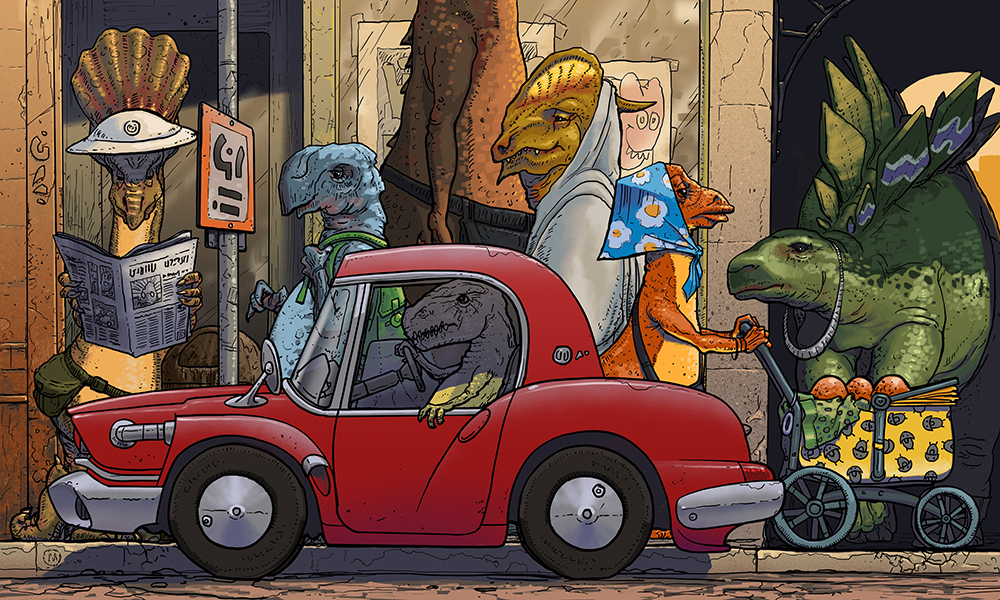Are we truly the first advanced Earthlings to inhabit this forth rock from the sun? Imagine if, many millions of years ago, dinosaurs drove cars through cities of mile-high buildings. A preposterous idea, right? Over the course of tens of millions of years, however, all of the direct evidence of a civilization — its artifacts and remains — gets ground to dust.
How do we really know, then, that there weren’t previous industrial civilizations on Earth that rose and fell long before human beings appeared?
It’s a compelling thought experiment, and one that Adam Frank, a professor of physics and astronomy at the University of Rochester, and Gavin Schmidt, the director of the NASA Goddard Institute for Space Studies, take up in a paper published in the International Journal of Astrobiology. Frank explains:
“Gavin and I have not seen any evidence of another industrial civilization.”
But by looking at the deep past in the right way, a new set of questions about civilizations and the planet appear: What geological footprints do civilizations leave? Is it possible to detect an industrial civilization in the geological record once it disappears from the face of its host planet?
“These questions make us think about the future and the past in a much different way, including how any planetary-scale civilization might rise and fall.”
In what they deem the “Silurian Hypothesis,” Frank and Schmidt define a civilization by its energy use. Human beings are just entering a new geological era that many researchers refer to as the Anthropocene, the period in which human activity strongly influences the climate and environment.
In the Anthropocene, fossil fuels have become central to the geological footprint humans will leave behind on Earth. By looking at the Anthropocene’s imprint, Schmidt and Frank examine what kinds of clues future scientists might detect to determine that human beings existed. In doing so, they also lay out evidence of what might be left behind if industrial civilizations like ours existed millions of years in the past.
Human beings began burning fossil fuels more than 300 years ago, marking the beginnings of industrialization. The researchers note that the emission of fossil fuels into the atmosphere has already changed the carbon cycle in a way that is recorded in carbon isotope records. Other ways human beings might leave behind a geological footprint include:
- Global warming, from the release of carbon dioxide and perturbations to the nitrogen cycle from fertilizers
- Agriculture, through greatly increased erosion and sedimentation rates
- Plastics, synthetic pollutants, and even things such as steroids, which will be geochemically detectable for millions, and perhaps even billions, of years
- Nuclear war, if it happened, that would leave behind unusual radioactive isotopes
“As an industrial civilization, we’re driving changes in the isotopic abundances because we’re burning carbon,” Frank says.
“But burning fossil fuels may actually shut us down as a civilization. What imprints would this or other kinds of industrial activity from a long dead civilization leave over tens of millions of years?”
The questions raised by Frank and Schmidt are part of a broader effort to address climate change from an astrobiological perspective, and a new way of thinking about life and civilizations across the universe. Looking at the rise and fall of civilizations in terms of their planetary impacts can also affect how researchers approach future explorations of other planets.
“We know early Mars and, perhaps, early Venus were more habitable than they are now, and conceivably we will one day drill through the geological sediments there, too,” Schmidt says.
“This helps us think about what we should be looking for.”
Schmidt points to an irony, however: If a civilization is able to find a more sustainable way to produce energy without harming its host planet, it will leave behind less evidence that it was there.
“You want to have a nice, large-scale civilization that does wonderful things, but that doesn’t push the planet into domains that are dangerous for itself, the civilization,” Frank says.
“We need to figure out a way of producing and using energy that doesn’t put us at risk.”
That said, the earth will be just fine, Frank says. It’s more a question of whether humans will be. Can we create a version of civilization that doesn’t push the earth into a domain that’s dangerous for us as a species?
“The point is not to ‘save the Earth,’” says Frank. “No matter what we do to the planet, we’re just creating niches for the next cycle of evolution. But if we continue on this trajectory of using fossil fuels and ignoring the climate change it drives, we human beings may not be part of Earth’s ongoing evolution.”
Provided by: University of Rochester [Note: Materials may be edited for content and length.]







